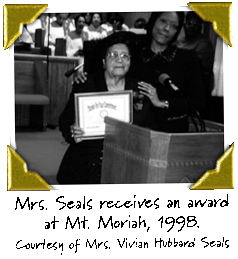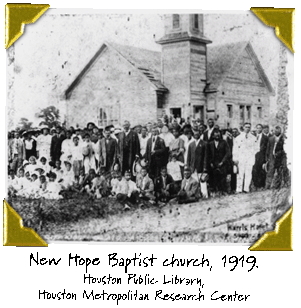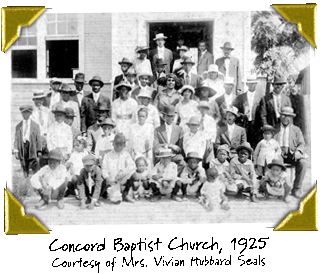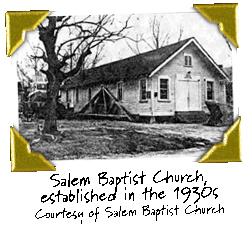

Home
| Contents | Next
The Spiritual Community
The
church has long been a pillar of strength in the African
American community. Even before the Civil War, black
Houstonians formed their own churches.
Accordingly,
from the birth of Independent Heights, a multitude of
churches sprang up and shaped the community’s culture.
Although the community only had about 400 members in
1914, only three years later, at least four churches
had been formed or were planned.
|
| _____
Vivian
Seals explained that she could not recall a time in her
life when she had not gone to church. “It was very important
for me [to go to church]. I have been in church all of my
life. There has never been a time in my life when I have
not been in church . . .” Independence Heights residents
since the 1950s, Jonas and Arlecie Bolton also stressed
the need to belong to the church while growing up. “It was
just very important,” said Mrs. Bolton. “Because it’s the
way you learn what life’s about–going to church and reading
and learning [about] what you’re supposed to be doing in
life.” |
 |
|
_____
Thanks
to the efforts of many families and individuals, Independence
Heights was filled with community churches. Lota Charles’
father was one of these influential church founders. Her
father helped organize two churches in Independence Heights–first,
Concord Baptist Church and later, Salem Baptist Church.
Mrs. Charles recollects that her father was both “a great
talker and organizer.”
_____
The
churches were not only the spiritual centers of Independence
Heights, but they were also social gathering spots where
children could be involved in different activities. Vivian
Seals vividly remembers the dramas and plays that her
childhood church, New Hope Baptist, would host. These
events would attract many community members. Neighborhood
children also found entertainment by joining the church’s
Starlight Band—an organization for local children. She
still can recall the songs she sang growing up as a child
in the church.
|

_____ New
Hope Baptist Church, which was formed in 1912, has the distinction
of being one of Independence Heights’ first churches. The
church’s congregation first met in Ella Davis’ home and
then under a tent on her lawn. When a fire destroyed the
tent, church members constructed a new meeting place from
dry senna bean stalks, which they dubbed “Brush Arbor.” |
| _____
Several
years later, the church secured permission to meet in the
Independence Heights School building. At last, in 1919,
the Wright Land Company granted New Hope Baptist Church
a lot on the 600 block of East 37th Street. Later, in 1927,
the church moved to its current location on the corner of
38th and North Main Streets. Archie and Richard Thompson,
two skilled contractors who lived in Independence Heights,
directed the construction of the new church. In 1989, the
New Hope Baptist Church became the location of the Independence
Heights State of Texas Historical Marker. |
 |

_____ Like
New Hope, Concord Baptist Church also began in the home
of an Independence Heights resident. Mr. Arthur McCullough
(later the city’s last mayor), began Concord Baptist in
1917 with the help of the Fourth Ward’s Antioch Baptist
Church. The Concord Baptist congregation met in the McCullough
home for three months, and then moved to Independence Heights
City Hall, which they rented. Reverend Louis Green Alexander
served as the first pastor. |
| _____
When
Concord’s congregation expanded to thirty-five members,
the church purchased a plot of land on the corner of North
Main and East 35th Street. The land cost the church just
$75, and the Purdy Lumber Company built the new church building
for $3,500. In 1951, Concord Baptist replaced its original
building with a new one that cost $100,000 to complete. |
 |
|

_____ In
1911, a small frame church building housing the first
African Methodist Episcopal church in the Independence
Heights area was organized and built at 618 East 34th
Street on land donated by the Wright Land Company. The
church was named after its first pastor, Reverend Richard
Green.

_____ Ebenezer
Methodist-Episcopalian Church started serving the Independence
Heights community in 1916. The early members met in Allen’s
Hall until 1922 when the church was able to save enough
money to purchase a building at North Main Street and
East 33rd Street.
.
_____ Around
1916 the Wright Land Company granted property to Independence
Heights to build a C.M.E. church in the 700 block of E.
37th Street. With the help of Bishop H.B. Porter and Elder
W.Q. Hunter the building was completed in 1916. This church
used to be known as “Aunt Sue Book’s church” because she
did everything for the church except serve as pastor.
Today the church is known as Sheeler Memorial Church and
is on E. 33rd Street at Columbia.

_____ In
1926 Rev. I. Brown joined forces with other influential
community members to form a new church. This group of
people bought land and built their new church at 7206
North Main Street. Although the original structure has
been rebuilt, the church is still in the same location.
|

_____ Though
it was not a church founded during the time of incorporation,
Salem Baptist church serves as a good example of how the
neighborhood community members combined forces to create
a new church. After serving as Independence Heights’ final
mayor, Mayor McCullough founded the Salem Baptist church
in 1934. |
| _____
The church
was organized in Cummings Hall, and the congregation worshipped
there for one year until a member of the church, Dora Porter,
offered the church a small plot of land on 33rd Street that
she had purchased for $12. Another church member, resident
carpenter, John Whitfield, along with Rev. McCullough and
Deacon Howard, together built the original church. Before
his death in 1974, Rev. McCullough began the funding drive
for the new church by personally making the first 100-dollar
donation. |
 |
Home
| Contents | Back to Top
Next
|
 |